Morse Elevator Works, c.1899-c.1910
1045-1055 and 1101-1103 Frankford Avenue
1105, 1107-1109, 1111-1119, 1121-1127 Frankford Avenue
1045-1049 Sarah Street
1100-1110 Shackamaxon Street
121-131 Wildey Street, Philadelphia PA 19125
© Stuart Paul Dixon,
Workshop of the
World (Oliver Evans Press, 1990).
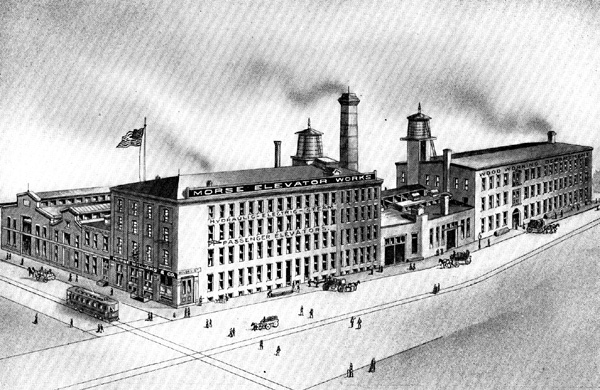
image adapted
from Moses
King
The industrial buildings located along the corners of
Frankford Avenue, Wildey, Sarah, and Shackamaxon Streets
form the earliest, extant, coherent industrial complex in
Fishtown. Associated with hosiery manufacture and
elevator construction, these buildings physically
document Fishtown's rich and diverse industrial history.
Built between 1851 and c.1920, the Martin Landenberger
Hosiery Mill consists of two brick buildings straddling
two corners of Frankford Avenue's intersection with
Wildey Street, at 1045-1055 and 1101-1103 Frankford
Avenue. The Morse Elevator Works, consisting of eight
brick buildings located at 1101-1103, 1105, 1107-1109,
1111-1119, and 1121-1127 Frankford Avenue, 1045-1049
Sarah Street, 1100-1110 Shackamaxon Street, and 121-131
Wildey Street, chronicles Philadelphia's association with
a series of elevator manufacturers who participated in a
nationwide marketplace. Most of the buildings in the
Morse complex, which includes one of the earlier
Landenberger buildings, were erected between 1899 and
circa 1910.
The oldest structure in the Landenberger complex stands
at 1101-1103 Frankford Avenue on the northeast corner of
Frankford and Wildey and exhibits two periods of
construction. Four bays wide along Frankford Avenue and
twenty bays deep, the mill stands four stories tall with
basement. The easternmost ten bays along Wildey contain
the earliest portion of the mill. Erected in 1851, this
half has a small gable-roofed cupola capping the eastern
half of the flat, tin-sheathed roof. Fenestration
displays Italianate stylistic arrangements; first-story
window bays are vertically longer than the upper-story
windows.
Italianate forms continue on the other ten bays along
Wildey Street. This half of the building dates from 1856,
the second period of construction. It has an elaborate
cast iron front on the ground level of its Frankford
Avenue elevation, and, like the earlier section, it is
four stories with a basement and stuccoed white. The
building's cast iron front has been painted with a
cementitious green paint to give the appearance of stone.
Three thin pilasters flanked by wider pilasters and
topped by acanthus leaf and floral capitals support an
entablature and cornice over the first-story bays.
Letters forming "MARTIN LANDENBERGER" are still dimly
visible in the frieze of the entablature. The upper
stories exhibit windows of varying height, echoing the
Italianate fenestration of the first period building.
Embedded in a second-story brickfilled bay of the earlier
portion of the building are the ends of iron beams and an
iron lintel. These pieces were part of an enclosed bridge
that crossed above Wildey Street and joined this building
to the one at 1045-1055 Frankford Avenue on the southeast
corner of Frankford Avenue and Wildey Street. The latter
building, made of brick, is ten bays wide along Frankford
Avenue and twelve bays deep on Wildey Street. This four
story with basement brick building exhibits three
distinct periods of construction, only one of which
relates to the Landenberger Mill. The earliest portion of
the building, constructed in 1871, encompasses the five
northernmost bays along Frankford Avenue and stretches
the full twelve bays along Wildey Street. The newest
section of this building, erected circa 1920, consists of
the four southernmost bays along Frankford Avenue. The
remaining bay on Frankford Avenue was constructed in 1881
as a cartway and stairway house, and was originally one
bay deep. It was expanded to the full twelve-bay depth
about 1920, when the latest section was added. The
original arched cartway entrance on the ground level has
been reworked and now includes modern glass doors.
Four buildings fronting on Frankford Avenue, all built
circa 1899, comprise the most intact portion of the
former elevator works constructed by Morse, Williams
& Co. A two-story-with-basement, three-bay-wide,
flat-roofed brick office building with sandstone sills
and water table stands at 1105 Frankford Avenue. The
buildings at 1107-1109, 1111-1119, and 1121-1127
Frankford all possess two stories, monitored gables on
their west elevations facing Frankford Avenue, and stone
water tables and sills. The building at 1107-1109
Frankford has three bays across its main elevation; a
central hoisting bay with double doors is flanked by
windows on both the first story and the second. The
building at 1111-1119 mirrors the one at 1107-1109 in
many respects, although taller and five bays wide. A date
stone in the peak of the monitor gable reads "1899." A
stone stringcourse caps the first-story bays of the three
buildings at 1105, 1107-1109, and 1111-1119 Frankford
Avenue and visually ties them together. The fourth
building, at 1121-1127 Frankford Avenue, displays
features similar to 1111-1119 Frankford, although
slightly taller and wider.
The building at 1100-1110 Shackamaxon Street was also
erected circa 1899 by Morse and contains two periods of
construction. The three-story, gable-roofed brick
structure is twelve bays deep along Wildey Street and ten
bays wide along its primary elevation on Shackamaxon
Street. The shed-roofed, northernmost three bays along
Shackamaxon Street are a later addition. The ghost
of letters spelling "Morse Elevator Works" can be seen in
the peak of the gable that faces Shackamaxon.
The two-story, eight-bay-wide brick building at 121-131
Wildey Street dates to about 1899. Originally one story
high, this structure received its second story after Otis
Elevator acquired the Morse Works in 1902. Two attached
one-story, gable-roofed machine shops erected after 1910
stand at 1045-1049 Sarah Street, on the southeast corner
of Wildey and Sarah.
In 1844, "stocking maker" Martin Landenberger employed
twelve hands in either a shop at his residence on St.
John Street near Green Street or as a tenant in a local
mill. An 1850 manufacturing census identified
Landenberger as a hosiery manufacturer in the Northern
Liberties, west of Fishtown, where he employed twenty
five men and one hundred women in the production of
$45,000 worth of hand-knit hose. The erection of his
first mill at 1101-1103 Frankford Avenue the next year
exemplifies the accumulation and reinvestment of private
capital that led to business expansion—a phenomenon
typical of successful industries in Fishtown and
Philadelphia during the nineteenth century.
Concentrating on the manufacture of woolen hosiery,
Landenberger by 1856 had expanded his operation, erecting
the 10 westernmost bays of 1101-1103 Frankford Avenue.
Edwin Freedley, who chronicled Philadelphia's industries
in 1859, tells us that Landenberger's mill was the only
large factory in Philadelphia to produce hosiery, opera
hoods, comforters, shawls, and scarfs. Freedley ends his
description of the mill by stating, "For cleanliness and
good arrangement, Mr. Landenberger's Kensington Woolen
Hosiery manufactory cannot be exceeded, and a visit to it
is a bona fide entertainment." 1
By 1860
Landenberger had a 12 h.p. steam engine running 124
knitting machines and 22 sewing machines. Hosiery, hoods,
and scarfs worth $275,000 were produced by 130 men and
300 women.
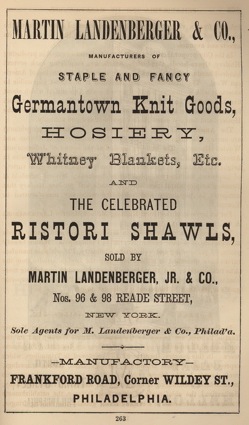
© Edwin T.
Freedley, Philadelphia
and its Manufactures (1867), p.
378.
Landenberger's hosiery and blankets found a swelling
market during the Civil War, as orders for the Union army
spurred sales. Landenberger continued expanding after the
war, increasing production and constructing part of the
mill at 1045-1055 Frankford Avenue in 1871. By 1874,
Landenberger employed 500 workers of predominantly
English and German heritage and processed over 250,000
pounds of American wool annually. A 15 h.p. steam engine
drove a wool-scouring machine, a picker, 10 twisting
machines with 400 spindles, a spinning department
consisting of eight mules with 2,560 spindles, and 15
power looms. Much of the machinery was fabricated in the
factory.
In 1880, according to Lorin Blodget, Landenberger's mill
had two steam engines producing 160 horse power; 12
carding machines with 5,800 spindles; 185 power knitters
consisting of 150 circular heads, 15 Balmorals, and 20
rib-top frames, heelers, and sleevers; 115 broad frames,
40 sewing machines, 209 power weaver looms, and 155
knitting frames. This machinery was used in the
production of 4,500 dozen hosiery and 4,000 dozen fancy
articles, hoods, shawls, cardigans, and scarfs per week,
as well as in the production of wool yarns and worsted
shawls and dress goods. 2
In 1882, Landenberger sold the properties but remained as
the new owners' agent and tenant at 1101-1103 Frankford
Avenue. In an 1883 industrial census, Landenberger is
listed as employing 330 people in the manufacture of knit
shawls, dress goods, and worsteds. Hodgkin and Co. also
rented space in the original Landenberger mill and
employed one hundred people in the production of cotton
and woolen hosiery. In 1886, the Morse, Williams &
Co., elevator manufacturers, acquired the mill building
at 1101-1103 Frankford Avenue.
Landenberger sold the building across Wildey Street, at
1045-1055 Frankford Avenue, to C. A. Thudium & Son,
manufacturers of cardigan jackets and knit goods. The
building then became known as the Oxford Knitting Mill.
Thudium & Son leased space to the firm of Ledger and
Ogden, which produced worsted yarn with three combs and
employed seventy two workers. The building continued as a
knitting mill under the ownership of William Barges in
the early 1900s. In 1919, Jacob Bloom purchased it and
commenced making bamboo novelties and furniture. After
the Alpha Shirt Company acquired the mill in 1977, it was
once again used as a textile mill.
In 1884, Stephen Morse, Carlton Williams, and Edwin
Morse, partners in the Clem & Morse Co., purchased
the former Landenberger buildings that stretched between
Frankford Avenue and Shackamaxon Street along Wildey
Street. These buildings included the former hosiery mill
at 1101-1103 Frankford Avenue. The three men then formed
the Morse, Williams & Co. in 1886, and began
producing passenger and freight elevators. Using six of
the eight floors in the former hosiery mill buildings,
the Morse Elevator Works constructed steam, belt, and
hand powered elevators with automatic hatch doors and
gates. One 23 h.p. steam engine and one 15 h.p. steam
engine powered woodworking machinery, including a planer,
a joiner, a mortising machine, a circular saw, and a
lathe. Fifty-eight men and twelve boys fashioned white
pine and metal castings into the various models of
elevators. Tenants in the building at this time included
A. J. Reach & Co., manufacturer of baseballs and
sporting goods, and the Standard Gas Light Company, which
produced gas fixtures.
According to an 1891 album, Philadelphia and Popular
Philadelphians, Morse became the world's leading producer
of freight elevators, "their specialties in the way of
automatic hatch doors, excellent safety devices and the
Albro-hindley screw having made an unusually high demand
for their freight elevators in all classes of buildings."
The Morse Elevator Works, "favorably situated for
shipping by both rail and water routes together with
their unsurpassed facilities for turning out work, added
to the general advantages of Philadelphia as a
manufacturing city, has enabled them to build up their
widely extended trade notwithstanding the strong
competition met from local manufacturers throughout the
country." 3
In spite of a court ruling in 1892 declaring senior
partner Stephen Morse a lunatic, Morse, Williams &
Co. continued to expand during the 1890s. Its exhibit at
the Chicago Columbian Exposition in 1893 won a prize
medal. The company employed approximately 175 men and
divided its buildings into space for offices, and
machinery, blacksmithing, and woodworking departments. It
opened branch offices in Boston, Allegheny City,
Scranton, Chicago, New York, Cincinnati, and Baltimore. A
special feature of a Morse-built elevator included the
"improved Hindley worm gearing [manufactured on site],
which obviates, by increasing the bearing surface of the
gear, the danger of breakage." 4
Morse embarked on
an ambitious building program in the late 1890s to meet
the increasing demand for its electric and hydraulic
high-speed passenger elevators. The buildings at 1105,
1107-1109, 1111-1119, and 1121-1127 Frankford Avenue,
1100-1106 Shackamaxon Street, and 121-131 Wildey Street
stand as evidence of this building expansion. By 1901 the
firm had moved its main office to the West End Trust
Building in center city Philadelphia and had opened new
branches in New Haven, Pittsburgh, and Atlanta. Over
fifteen thousand Morse elevators were in service at that
time.
The Otis Elevator Company, after purchasing Morse,
Williams & Co. in 1902, proceeded to purchase
property on the corner of Wildey and Sarah Streets. On
this land Otis erected the two metalworking shops at
1045-1049 Sarah Street. A three-bay wing attached to the
north side of the building at 1100-1106 Shackamaxon
Street gave the building at 1100-1110 Shackamaxon its
present appearance. A 1916 industrial census describes
the Otis Elevator Company as employing ninety men and
women in the production of elevators and hoists at 1105
Frankford Avenue. At the same address, the Hindley Gear
Co. fabricated machinery and parts; it employed four men
and one woman. Otis sold the properties in 1943.
Guilbert, Inc., acquired most of the former Morse
buildings in 1949 and produced elevators and dumbwaiters.
Guilbert's successor, the American Sterilizer Company,
sold the buildings to the Montgomery Elevator Company in
1976. Montgomery continued Fishtown's association with
the manufacture of elevators until 1987. Today, the
former Morse Elevator Works houses a machine works, a
warehouse for ice cream equipment, another warehouse for
construction equipment, and a sanitary-clothing
manufacturer.
1 Edwin T.
Freedley, Philadelphia
and Its Manufactures, (Philadelphia, 1859), p.
243.
2 Lorin Blodget,
Census
of Philadelphia Manufactures (Philadelphia, 1880), pp. 22,
25.
3 Philadelphia
and Popular Philadelphians, (Philadelphia, 1891), p.
120.
4 Frank H. Taylor,
editor, The
City of Philadelphia as it Appears in the Year
1894 (Philadelphia, 1894), p. 233.
Update May
2007 (by
Torben Jenk):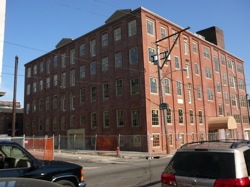
1039-1055
Frankford Avenue (southeast corner of Wildey Street,
formerly Bedford): Conversion to residential use is
underway, although the work has been stalled for months.
The exterior brick has been cleaned and pointed, and new
windows were installed. The original building, built in
1871 and 1882, is closest to the corner (Hexamer
#871-871). Bromley Atlases shows the "Oxford Knitting
Mills" (1895, plate 13) and "Cedar Chest
Fact." (1922, plate 10). A carved marble plaque on
the Frankford Avenue facade is severely weathered, but
seems to read "JACOB BLOO..." [probably Jacob Bloom Co.].
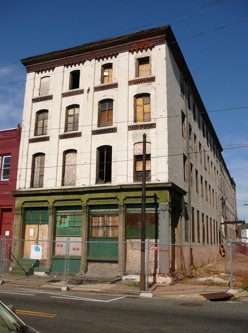
1101-1103
Frankford Avenue (northeast corner of Wildey, formerly
Bedford): This building sits vacant and is deteriorating.
Charming Italianate proportions and details remain,
including the window sash, brick dentils under the third
and fourth floor window sills, and the corbelled brick
cornice capped with wood. The cast iron columns along the
first floor were covered in "sand paint" to evoke
masonry. Unfortunately, most of the brick was covered
with a thin white stucco wash, perhaps as a waterproofer.
A small marble sign inset on the corner reads, "BEDFORD,"
the former street name for Wildey. Purchased in 2004 for
$525,000 and now wrapped in construction fencing, the
building will probably be converted to residences.
121-131 East Wildey Street (north side, between Frankford
and Shackamaxon, where block bends):Occupied by
Philadelphia Vending Company, which builds and repairs
food vending carts, a common site around local
universities and designated street corners with their
"quilted stainless" sides. Quilting adds diamond shaped
creases in the polished stainless.
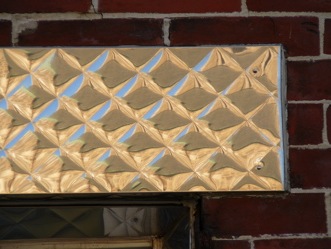
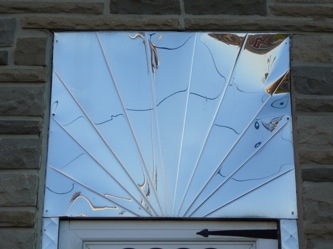
This durable
material is also found throughout Fishtown covering
window heads, trim, and sills. Semicircular transoms
sometimes feature a "star burst." Cast concrete floors
and joists are visible through the workshop doors.
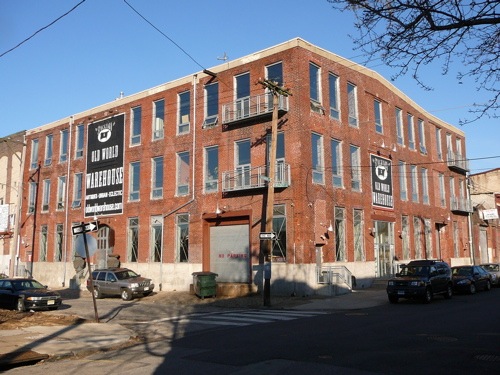
1100-1106
Shackamaxon Street: Converted around 2004 into twelve
apartments atop first floor commercial space (one
business sells salvaged "architectural antiques").
Marketed with huge painted signs proclaiming "Old World
Warehouse" and "Stockyard" (with a steer with a '$'
brand!), the more careful observer will see 'MORSE
ELEVATOR WORKS' spelled in brick in the shallow pediment
atop the Shackamaxon Street side.
1108-1110 Shackamaxon Street: Recently used as a marble
cutting and finishing shop (for kitchen counters). Now
vacant.
1045-1049 Sarah Street (southeast corner of Wildey): Used
as a restoration workshop by Sky Top Rover, an enthusiast of classic
British Army surplus Land Rovers and other British
vehicles of that era—the original Mini, the
Morris Minor, and Bedford Ambulances. The vehicles
provide a contrast to the real estate speculators who
arrive on the block in their Ferraris waving pinky
rings. This block of Wildey retains its cobblestone
paving.
See
also:
Hexamer General Survey
#98 (1866), "Martin Landenberger's Hosiery
Factory."
Hexamer General Survey #781-782 (1874),
"Martin Landenberger & Co., Hosiery
Factory."
Hexamer General Survey
#1619 (1882), "Landenberger's Mill, Thos A. Bond,
Owner."
Hexamer General Survey
#2016 (1886), "Morse Elevator Works, Morse,
Williams & Co."